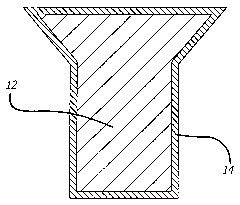Some of the information on this Web page has been provided by external sources. The Government of Canada is not responsible for the accuracy, reliability or currency of the information supplied by external sources. Users wishing to rely upon this information should consult directly with the source of the information. Content provided by external sources is not subject to official languages, privacy and accessibility requirements.
Any discrepancies in the text and image of the Claims and Abstract are due to differing posting times. Text of the Claims and Abstract are posted:
| (12) Patent Application: | (11) CA 2550444 |
|---|---|
| (54) English Title: | IMPROVED RIVET AND COATING TECHNIQUE |
| (54) French Title: | RIVET AMELIORE ET TECHNIQUE DE REVETEMENT |
| Status: | Deemed Abandoned and Beyond the Period of Reinstatement - Pending Response to Notice of Disregarded Communication |
| (51) International Patent Classification (IPC): |
|
|---|---|
| (72) Inventors : |
|
| (73) Owners : |
|
| (71) Applicants : |
|
| (74) Agent: | SMART & BIGGAR LP |
| (74) Associate agent: | |
| (45) Issued: | |
| (86) PCT Filing Date: | 2004-11-18 |
| (87) Open to Public Inspection: | 2005-07-07 |
| Availability of licence: | N/A |
| Dedicated to the Public: | N/A |
| (25) Language of filing: | English |
| Patent Cooperation Treaty (PCT): | Yes |
|---|---|
| (86) PCT Filing Number: | PCT/US2004/039125 |
| (87) International Publication Number: | WO 2005060497 |
| (85) National Entry: | 2006-06-16 |
| (30) Application Priority Data: | ||||||
|---|---|---|---|---|---|---|
|
A previously heat treated aluminum alloy rivet is sand blasted with aluminum
oxide, washed with a corrosion resistant solution, dried, and then a coating
is applied to the rivet. The coating includes solvent, resin, plasticizer and
a corrosion inhibitor. The coating is cured at an elevated temperature below
300~F, preferably in the order of 250~F for about an hour, or between one-half
and one and one-half hours. The resultant rivet has a relative thick gasket-
like coating about 0.0007 to about 0.001 or 0.002 inch thick, and retains its
high shear strength resulting from the initial pre-coating heat treatment. As
an alternative pre-treatment, the rivets may be chromic acid anodized.
L'invention concerne un rivet en alliage d'aluminium traité thermiquement au préalable, qui est sablé avec de l'oxyde d'aluminium, puis lavé avec une solution résistant à la corrosion, séché, avant application d'un revêtement audit rivet. Le revêtement comprend un solvant, une résine, un plastifiant et un inhibiteur de corrosion. Le revêtement est cuit à une température élevée inférieure à 300 ·F, de préférence de l'ordre de 250 ·F, pendant approximativement une heure, ou entre une demi-heure et une heure et demie. Le rivet qui en résulte présente un revêtement de type garniture relativement épaisse, de l'ordre d'approximativement 0,0007 à approximativement 0,001 ou 0,002 pouce d'épaisseur, et conserve sa résistance élevée au cisaillement, résultant du traitement thermique de prérevêtement initial. Un autre traitement préalable consiste à anodiser les rivets à l'acide chromique.
Note: Claims are shown in the official language in which they were submitted.
Note: Descriptions are shown in the official language in which they were submitted.

2024-08-01:As part of the Next Generation Patents (NGP) transition, the Canadian Patents Database (CPD) now contains a more detailed Event History, which replicates the Event Log of our new back-office solution.
Please note that "Inactive:" events refers to events no longer in use in our new back-office solution.
For a clearer understanding of the status of the application/patent presented on this page, the site Disclaimer , as well as the definitions for Patent , Event History , Maintenance Fee and Payment History should be consulted.
| Description | Date |
|---|---|
| Time Limit for Reversal Expired | 2008-11-18 |
| Application Not Reinstated by Deadline | 2008-11-18 |
| Deemed Abandoned - Failure to Respond to Maintenance Fee Notice | 2007-11-19 |
| Inactive: Cover page published | 2006-09-01 |
| Letter Sent | 2006-08-24 |
| Inactive: Notice - National entry - No RFE | 2006-08-24 |
| Application Received - PCT | 2006-07-24 |
| National Entry Requirements Determined Compliant | 2006-06-16 |
| Application Published (Open to Public Inspection) | 2005-07-07 |
| Abandonment Date | Reason | Reinstatement Date |
|---|---|---|
| 2007-11-19 |
The last payment was received on 2006-11-03
Note : If the full payment has not been received on or before the date indicated, a further fee may be required which may be one of the following
Please refer to the CIPO Patent Fees web page to see all current fee amounts.
| Fee Type | Anniversary Year | Due Date | Paid Date |
|---|---|---|---|
| Basic national fee - standard | 2006-06-16 | ||
| Registration of a document | 2006-06-16 | ||
| MF (application, 2nd anniv.) - standard | 02 | 2006-11-20 | 2006-11-03 |
Note: Records showing the ownership history in alphabetical order.
| Current Owners on Record |
|---|
| INNOVATIVE COATINGS TECHNOLOGY CORPORATION |
| Past Owners on Record |
|---|
| ROBERT E. BRILEY |